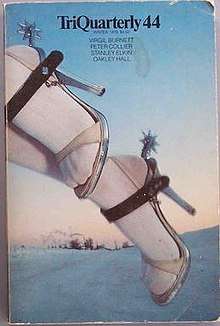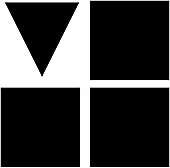TriQuarterly
TriQuarterly is a name shared by an American literary magazine and a series of books, both operating under the aegis of Northwestern University. The journal is published twice a year and features fiction, nonfiction, poetry, drama, literary essays, reviews, a blog, and graphic art.
 | |
| Categories | Literary magazine |
|---|---|
| Frequency | Biannual |
| Publisher | Northwestern University |
| First issue | 1958 |
| Country | United States |
| Based in | Evanston |
| Website | www |
| ISSN | 0041-3097 |
| OCLC | 889376903 |
Founding
TriQuarterly journal was established in 1958[1] as an undergraduate magazine remembered now for publishing the work of young Saul Bellow.[2] It was reshaped in 1964 by Charles Newman as an innovative national publication aimed at a sophisticated and diverse literary readership.[3] Northwestern University Press, the university's scholarly publishing arm, operated the journal.[4] The journal was so named because its original form as a student magazine was published in each of the three quarters of Northwestern's academic year, and not in the fourth quarter, summer.
Book Series
In 1990, Northwestern University Press established a series of new works of fiction and poetry under the imprint name TriQuarterly. Writers such as Nikky Finney, Christine Schutt, A. E. Stallings, Patricia Smith, Bruce Weigl, and Angela Jackson have published titles in the imprint, including works that have won the National Book Award, Whiting Awards, the Kingsley Tufts Poetry Award, and the Hurston-Wright Legacy Award.[5]
Format Change
On September 21, 2009, Northwestern University announced three changes to the journal. First, rather than continue under the aegis of Northwestern University Press with paid, professional editors, the journal would become a student-edited publication in 2010. Second, the print edition would cease and the journal would become digital only. Third, the journal would move from the press to the Master of Fine Arts in Creative Writing program (part of Northwestern University's Department of English).[6] The first online edition of TriQuarterly Online, Issue 138, continuing the numbered issue sequence to show continuity from the print edition, launched on July 5, 2010 at the website: Triquarterly.org.[7]
Periodicals as varied at the Chronicle of Higher Education and The New Yorker expressed the displeasure of the literary world at the change. One writer described the literary community as "surprised, saddened, shocked" by the change as well as "dismayed" that the journal's editor and associate editor would not be included in the move. Jeffrey Lependorf, executive director of the Council of Literary Magazine and Presses, said the change "doesn’t feel like the passing of the torch; it feels like the extinguishing of the flame.”[8] Another wrote that it highlighted "a harrowing trend in publishing and in academia: the replacement of experienced, paid professionals with under- (or un-) paid casual labor—whether bloggers, graduate students, or adjuncts who often receive neither benefits nor job security."[9]

After the university reassigned TriQuarterly journal to the Department of English, Northwestern University Press continued to acquire and publish books in the TriQuarterly imprint, which is edited by Parneshia Jones.[10]
Influence
The physical aspect of many literary journals today derives from the creation of the TriQuarterly design in 1964, credited in The New Yorker as "a venerated publication (it is credited with having pioneered the literary-quarterly format)."[11] By publishing a combination of general issues and occasional special issues, such as for Vladimir Nabokov on his seventieth birthday; Prose for Borges; and The Little Magazine in America: A Modern Documentary History, TriQuarterly quickly became one of the most widely admired and important American literary journals.
Recognition
The New York Times has called TriQuarterly "perhaps the preeminent journal for literary fiction" in America.[12]
See also
References
- "Top 50 Literary Magazine". EWR. Retrieved August 17, 2015.
- Howard, Jennifer. "Literary Circles Reel at Northwestern's Plans for 'TriQuarterly'". Chronicle.com. The Chronicle of Higher Education. Retrieved 26 May 2020.
- Margalit Fox (March 22, 2006). "Charles Newman, 67, Writer and Literary Journal Editor, Dies". The New York Times. Retrieved June 1, 2009.
- Halford, Macy. "A New Life for TriQuarterly?". NewYorker.com. Condé Nast. Retrieved 26 May 2020.
- Staff writer. "TriQuarterly". Northwestern University Press. Northwestern University. Retrieved 26 May 2020.
- Halford, Macy. "A New Life for TriQuarterly?". NewYorker.com. Condé Nast. Retrieved 26 May 2020.
- "Northwestern Reaffirms Commitment to University Press; TriQuarterly Magazine Goes Electronic". Northwestern University News Center. September 21, 2009. Retrieved September 22, 2009.
- Howard, Jennifer. "Literary Circles Reel at Northwestern's Plans for 'TriQuarterly'". Chronicle.com. The Chronicle of Higher Education. Retrieved 26 May 2020.
- Halford, Macy. "A New Life for TriQuarterly?". NewYorker.com. Condé Nast. Retrieved 26 May 2020.
- Kirch, Claire. "Meet the Editor: Parneshia Jones". Publishers Weekly. Publishers Weekly. Retrieved 26 May 2020.
- Halford, Macy. "A New Life for TriQuarterly?". NewYorker.com. Condé Nast. Retrieved 26 May 2020.
- McDowell, Edwin (March 18, 1983). "PUBLISHING: STARTING OUT IN THE LITTLE MAGAZINES". New York Times. New York Times Corporation. Retrieved 21 November 2018.